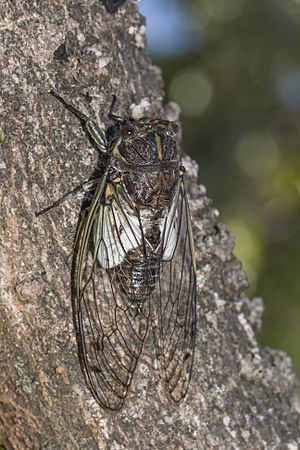White drummer cicada facts for kids
Quick facts for kids White drummer cicada |
|
|---|---|
 |
|
| Arunta perulata, live male | |
 |
|
| male specimen | |
| Scientific classification | |
| Kingdom: | |
| Phylum: | |
| Class: | |
| Order: | |
| Family: |
Cicadidae
|
| Genus: |
Arunta
|
| Species: |
A. perulata
|
| Binomial name | |
| Arunta perulata Guérin-Méneville (1831)
|
|
| Synonyms | |
|
Cicada perulata Guérin-Méneville |
|
The Arunta perulata is a large cicada from Australia. It is often called the white drummer cicada. Long ago, it was also known as the "floury baker." But now, that name belongs to a different cicada species called Aleeta curvicosta.
A scientist named Félix Édouard Guérin-Méneville first described this cicada in 1831. He gave it the name Cicada perulata.
Contents
About the White Drummer Cicada
What Does It Look Like?
The white drummer cicada is quite big! Male cicadas are about 3.75 centimeters long. Females are almost the same size, around 3.72 centimeters.
Its head is green with dark reddish-brown marks. A green line runs down its back. Its eyes are a dark reddish-brown color. The body, including its chest and belly, is mostly dark reddish-brown. Some parts of its body have soft, yellow fur.
One special thing about this cicada is its white, sac-like covers. These covers help make its loud sound. The cicada's clear wings have reddish-brown and yellowish lines. Male wings can be up to 4.97 centimeters long. Female wings are a bit shorter, about 4.84 centimeters. The white drummer has yellow-green legs with dark brown and black spots.
Its Amazing Call
The white drummer cicada makes a very loud, constant rattling sound. You can hear its call from far away! It sings during the day and as the sun sets.
The sound is made of many quick pulses. These pulses happen very fast, about 65 times every second. Each pulse is super short, lasting only a tiny fraction of a second. The sound is high-pitched, around 5.5 to 6.5 kilohertz.
Like its cousin, the double drummer cicada (Thopha saccata), the white drummer uses its special sac-like covers to make its call even louder. These covers act like natural amplifiers!
Where Does It Live?
You can find the white drummer cicada along the eastern coast of Australia. It lives from Cooktown in northern Queensland all the way down to Narooma in southern New South Wales. It has also been seen in the very northern part of Cape York.
These cicadas love swampy forests and mangrove areas. They often perch on trees like the sheoak (Casuarina equisetifolia), swamp oak (C. glauca), coast banksia (Banksia integrifolia), and coast wattle (Acacia sophorae). Adult white drummer cicadas usually appear in December and January.
Reproduction
Female cicadas lay their eggs only on live tree branches.


